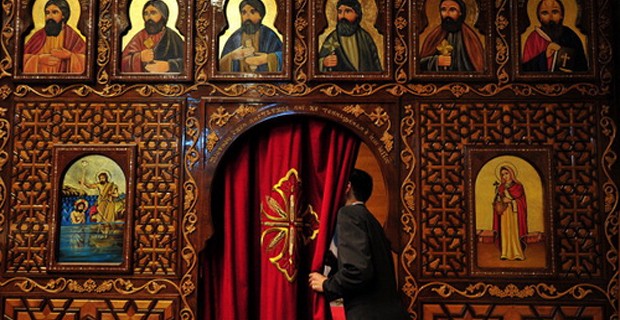
“Out of Egypt I called my son.” — Hosea 11:1
In the Gospel of Matthew, the advent of the Messiah is followed by an abrupt departure. Almost immediately after the Magi visit them, the Holy Family takes off forEgyptbecause Joseph has been warned in a dream that King Herod would kill the infant Jesus. The narrative then fast forwards through three-and-a-half years of exile which are terminated by yet another angel in a dream.
This three year gap left by Scripture is filled in by Coptic Christian tradition.
The Coptics are an orthodox branch of Christianity that split from the Church following the Council of Chalcedon in 451 AD. In their tradition, alongside the familiar stories of the annunciation, the shepherds in the field, and the baby wrapped in swaddling clothes, the Coptics have other stories — of the infant Jesus who held up his hand to stop a stone from falling on Mary, of idols that fell down before the Incarnate God, and of miraculous trees and spontaneous springs that sheltered and nurtured the Holy Family.
“It is something to be proud of — that they visited our places,” said Maryhan Nagy, a first-year university student whom I interviewed last summer at the Hanging Church in the Coptic quarter of Cairo. “It is a very great blessing to visit a place in which the Christ visited.”
In fact, several of them were within a short walk of the church.
The nearby Church of Saint Sergius, for example, was built over a cave which, according to tradition, was a hiding place for the Holy Family. A chapel in the adjoining Greek Cemetery still has the well from which, according to Coptic tradition, they drank two millennia ago. And one woman I met at the Hanging Church— so called because it is built over a Roman water gate — even claimed that the Holy Family had eaten the fruit from two palm trees in the outside courtyard.
No doubt, while some stories are more credible than others, the idea that Egypt has a special role to play in salvation history is affirmed throughout Scripture — not only in Matthew but also throughout the Old Testament, most notably Isaiah 19:
See, the Lord is riding on a swift cloud on his way to Egypt; The idols of Egypt tremble before him, the hearts of the Egyptians melt within them…On that day there shall be an alter to the Lord in the land of Egypt, and a sacred pillar to the Lord near the boundary.
The heritage the Coptic Church has bequeathed to us lives up to this special calling. It is, after all, the church that gave us Saint Athanasius — the first church father to develop a list of New Testament books. It is also the home of Christian monasticism which St. Anthony and the other ‘Desert Fathers’ pioneered in the third century.
It is this deeply felt connection to Scriptural prophecy and the Holy Family that perhaps explains the survival of the Coptic Church through nineteen centuries of history — most of it under Muslim rule. Today, the Coptic Church remains a small but vibrant minority in a country that is 90 percent Muslim.
The Coptic Church — along with the Ethiopian Orthodox — are part of the Oriental Orthodox communion that separated from the rest of Christendom after the Council of Chalcedon in 451 AD. The council had held that Christ had two natures, such that he was fully man and full God. The dissenters also insisted he was both man and God, but they believed those two natures were fused into one in the person of Christ.
When I sat in on the Divine Liturgy at theHanging Church, I found a congregation willing to embrace other Christians with a degree of hospitality and openness that I confess scandalized me initially. After the end of an elaborate, hours-long service, I had withdrawn inconspicuously to the back of the church to watch everyone else file out. However, my attempt to go unnoticed failed. Before long, a father and son approached me. Neither of them spoke any English. Instead, the son extended his arm to me. In his hand, he was holding a piece of bread. When I didn’t take it, he pulled back, and then thrust it out again.
As a Catholic, I was quite taken aback by the encounter. Given that the Divine Liturgy had just ended, I concluded that this had to be Eucharistic bread. The idea of a child — anyone — sauntering out of church with the Eucharist in hand was, to say the least, startling.
Later during my trip, I was enlightened about this encounter by a college-age woman, Marian Magdy, whom I met at the Hanging Church. She explained that there are, in fact, two kinds of bread dispensed at the Coptic liturgy. The first kind does indeed become the Body of Jesus. But there is a second bread, called the loma baraka in Arabic, or, ‘The Bread of the Blessing,’ which is not Eucharistic. This second bread, she said, is meant to be shared with the ‘people’ — presumably including guests and strangers such as myself.
In retrospect, the boy’s offer of bread was a touching act of Christian charity — an extension of fellowship that left a lasting impression. So, while the visitation of the young Jesus and his parents to specific places in this land is verified only by tradition, Christ’s presence amidst his followers in Egypt is made manifest in their faith, their devotion and their insistent welcoming of strangers in his name.
